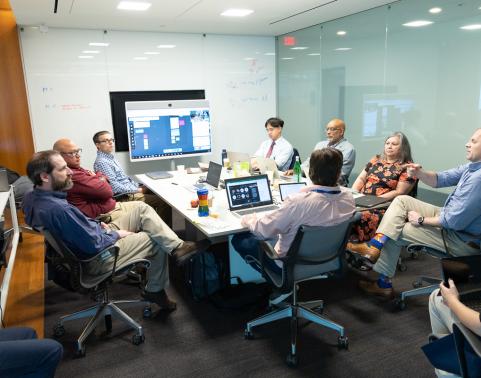PEO EIS to change the way it acquires software

Effective Oct. 1, 2023 — the beginning of the government’s fiscal year 2024 — the way Program Executive Office Enterprise Information Systems (PEO EIS) acquires software will change in alignment with the Army’s digital transformation.
Based on new policy guidance on software support funding issued in May 2023 from the Assistant Secretary of the Army for Acquisition, Logistics and Technology [ASA(ALT)], PEOs and program managers (PMs) will no longer transition software to sustainment. Instead, they will employ a continuous integration/continuous delivery model in which software is continuously and iteratively developed and upgraded throughout the acquisition lifecycle. To support this transition, the Army is changing its funding processes to allow funds to be allocated directly to programs.
What this means in practical terms is that the current model in which PEO EIS’s project management offices (PMO) develop software and then transition it to the Army Materiel Command (AMC) for sustainment and maintenance will no longer exist. Instead, PMOs will manage the entire process — from software development through functional execution and enhancements — including determining whether Operations and Maintenance, Army (O&MA) or Research, Development, Test, & Evaluation (RDT&E) funding is needed for the project. Rather than funding dollars flowing from a central sustainment fund to AMC, they will be allocated to programs through the Army’s annual Program Objective Memorandum (POM) process.
“Under the new direction, I think the shift is going to be a lot less O&MA and more RDT&E,” said Aric Sherwood, director of PEO EIS’s Acquisition Innovation Directorate.
Sherwood said that with Agile software development, programs are never really in maintenance mode; they are always in enhancement mode. “As we deploy software and the user requires enhancements, it will require development money,” he said.
The Army’s new software support funding guidance followed a Network Capability Portfolio Review (N-CPR) in which leaders evaluated digital requirements across the Army and determined, with an eye toward sustainment over the Future Years Defense Program (FYDP), the feasibility of the policy shift in the funding process.
The change in how PEO EIS acquires software represents another step in the organization’s journey to becoming fully Agile.
“I think it’s a good move,” Sherwood said of the policy change. “As the Army takes this journey to digital transformation, the way we acquire, develop, deploy and sustain software is changing to better match what our industry partners are doing.” He added that by making the move, the Army is aligning with software development best practices.
Another component to the shift is whom it impacts. The policy applies to programs that are planning to wrap up development activities and pursue enhancements in FY 2024 and beyond. There will be no change to those programs already in sustainment — like PEO EIS’s Reserve Component Automation System (RCAS), which is part of the Integrated Personnel and Pay System – Army (IPPS-A) portfolio. RCAS, a web-based solution that helps the Army Reserves maintain mobilization, safety, personnel and force authorization requirements, is already in sustainment; therefore, its funding source will remain the same, said Pat McKinney, IPPS-A’s deputy project manager.
“If you’re in sustainment, you stay there,” said McKinney. “This is about pivoting for the future.”
Similarly, PEO EIS’s enterprise resource planning (ERP) programs that currently reside at the Army Communications-Electronics Command (CECOM) Software Engineering Center (SEC) Army Shared Services Center (SSC) are expected to remain there. The ERPs eventually will be consolidated as part of the Army’s Enterprise Business Systems – Convergence (EBS-C) initiative.
So far, PMs at PEO EIS seem on-board with the policy change.
“Initially, we thought there might be a lot of pushback,” Sherwood said. “But we’re getting a lot of support from the Army community as we’re sorting out what it looks like to best support the Soldier as we move forward.”
Related News
-
Onedia James: a logistician and leader with a family legacy of service
April 22, 2025Onedia James recently stepped into the role of acting deputy project manager for Army Data and Analytics Platforms (ARDAP) at U.S. Army Program Executive Office (PEO) Enterprise, where she helps oversee and support the data portfolio’s four programs. -
PEO Enterprise’s new PL Digital Market reimagines IT product/service procurement
April 2, 2025FORT BELVOIR, Va. – U.S. Army Program Executive Office (PEO) Enterprise today announced the launch of the Product Lead (PL) Digital Market, which replaces PL Computer Hardware, Enterprise Software and Services (CHESS), effective Apr. 2, 2025. -
Two vastly different Army programs prepare for Software Acquisition Pathway
March 24, 2025At U.S. Army Program Executive Office Enterprise, which is now over two years into its Agile transformation, several enterprise software programs are already in the execution phase of the DOD’s Software Acquisition Pathway, which is designed to facilitate rapid and iterative delivery of software capability to users.
Work for Us
Join a winning team! Search for job opportunities with PEO Enterprise.
Work with Us
Help support important missions. Explore ways your company can work with PEO Enterprise.